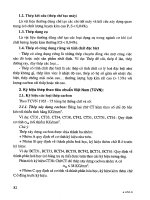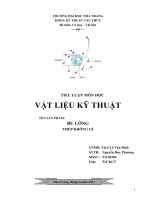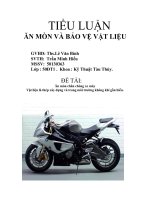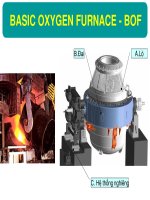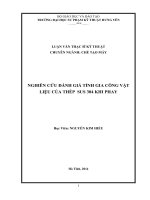Vật liệu thép theo ASTM
Bạn đang xem bản rút gọn của tài liệu. Xem và tải ngay bản đầy đủ của tài liệu tại đây (230.95 KB, 21 trang )
CIE 428 Module A Instructor: Andrew Whittaker
8/21/2002 8:39 AM 1
MODULE A: INTRODUCTION
This module of CIE 428 covers the following subjects
Specifications for design of steel structures
Structural steel
Grades of steel
Steel shapes
Properties of structural steel
Concepts in structural steel design
Basis of load and resistance factors
READING: Chapters 1 and 2 of Segui
Chapters 1 and 2 of Bruneau et al.
AISC LRFD Manual of Steel Construction, 3rd
Ed.
SPECIFICATIONS
There are two key specifications for the design of steel structures
1. American Institute of Steel Construction (AISC)
Design of steel buildings and connections
www.aisc.org
CIE 428 Module A Instructor: Andrew Whittaker
8/21/2002 8:39 AM 2
2. American Association of State Highway and Transportation
Officials (AASHTO)
Design of steel/reinforced concrete/timber bridges
www.aashto.org
Other specifications are available from
American Iron and Steel Institute (AISI)
Cold-formed steel structures
www.steel.org
American Railway Engineering Association
Steel railway bridges
STRUCTURAL STEEL
History of engineered construction using metals
Iron
Chief component of steel
Wrought iron first used for tools around 4000 BC
Produced by heating ore in a charcoal fire
Cast and wrought iron used in the late 18C and early 19C
in bridges
CIE 428 Module A Instructor: Andrew Whittaker
8/21/2002 8:39 AM 3
Steel
An alloy of primarily iron and carbon
Fewer impurities and less carbon than cast iron
Began to replace iron in construction in the mid 1800s
First steel railroad bridge in 1874
First steel framed building in 1884
GRADES OF STEEL
Numerous grades of steel are available in the marketplace. The
choice is dependent on
Application
Yield strength
Composition
See the summaries on the following sheets from the textbook of
Gaylord et al.
ASTM A36, A53, A242, A572, A709
Tensile properties
CIE 428 Module A Instructor: Andrew Whittaker
8/21/2002 8:39 AM 4
STEEL SHAPES
Hot-rolled shapes are produced from molten steel in a furnace that
is poured into a continuous casting where the steel solidifies but
does not cool completely. The partially cooled steel is then passed
through rollers to achieve the desired shape.
Common structural steel shapes are shown below (from Segui).
CIE 428 Module A Instructor: Andrew Whittaker
8/21/2002 8:39 AM 5
A sample designation of a steel shape is
W18x50
Bar, plate and HSS shapes are shown below.
Hollow steel sections (HSS) are fabricated by either
bending plate material into the desired shape and seam
welding or hot-working to produce a seamless shape
PROPERTIES OF STRUCTURAL STEEL
Stress-strain relationship
CIE 428 Module A Instructor: Andrew Whittaker
8/21/2002 8:39 AM 6
The stress-strain relationship is the best-known characterization of
steel. See the figure below from Segui.
Stress is denoted as f or
σ
, and is calculated as
P
f
A
=
Engineering stress
Strain is denoted
ε
and is calculated as
L
L
ε
∆
=
CIE 428 Module A Instructor: Andrew Whittaker
8/21/2002 8:39 AM 7
Engineering strain
The figure above shows 4 ranges of response
Elastic
Plastic (yield plateau)
Strain hardening
Necking and failure (strain softening)
Many steels are ductile. Ductility is a measure of post-yield
elongation, where elongation is calculated as
0
0
()
f
LL
e
L
−
=
where
f
L =
0
L =
An idealized stress-strain relationship is shown in the figure on the
following page from Segui. The important descriptors are
y
F
: the yield point
u
F
: the ultimate tensile strength
CIE 428 Module A Instructor: Andrew Whittaker
8/21/2002 8:39 AM 8
E: Modulus of elasticity or Young’s modulus (29,000 ksi)
For high-strength steels, the stress-strain relationships are often
similar to that shown below (from Segui).
Note from the above figure that
Elastic range
No well-defined yield point


